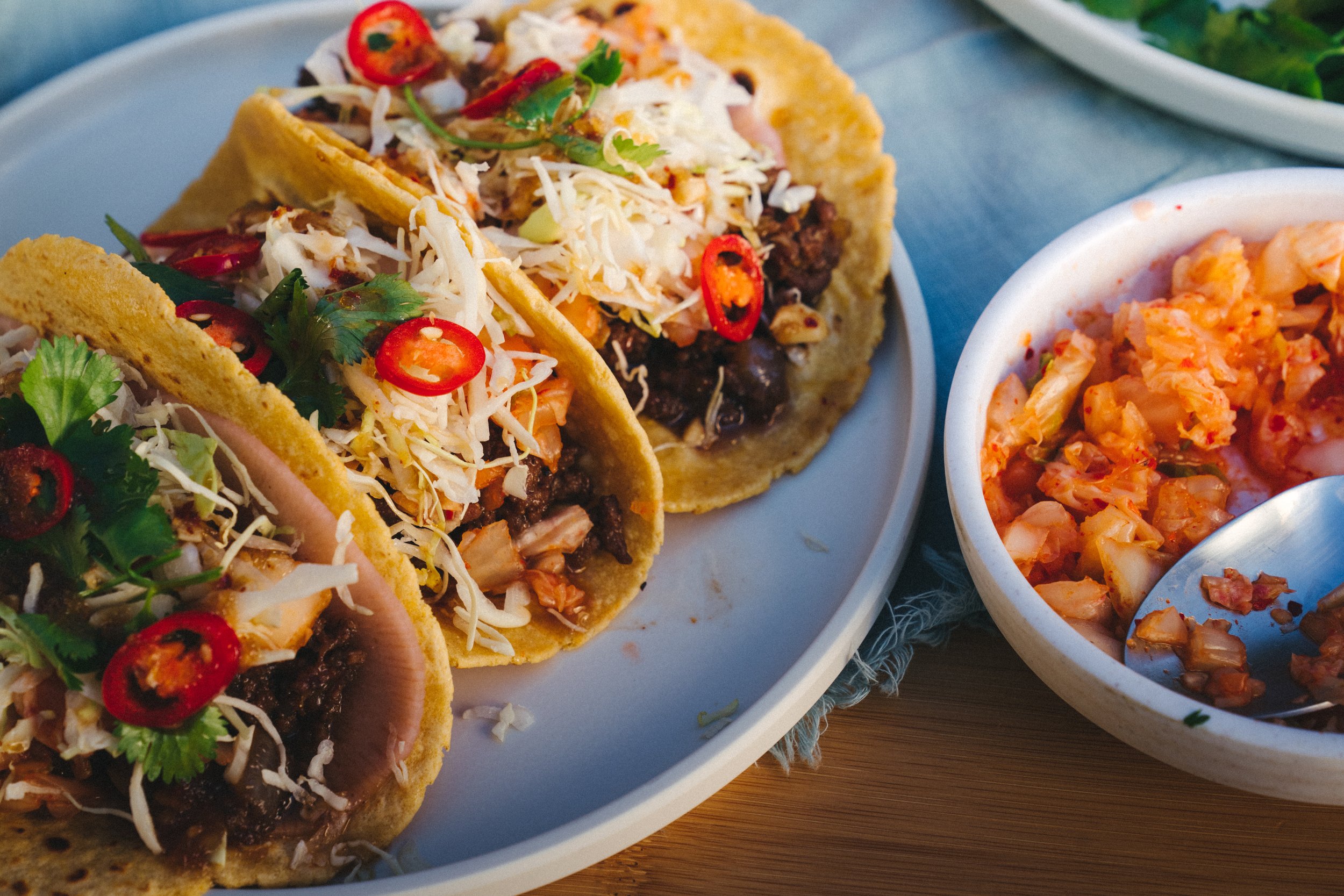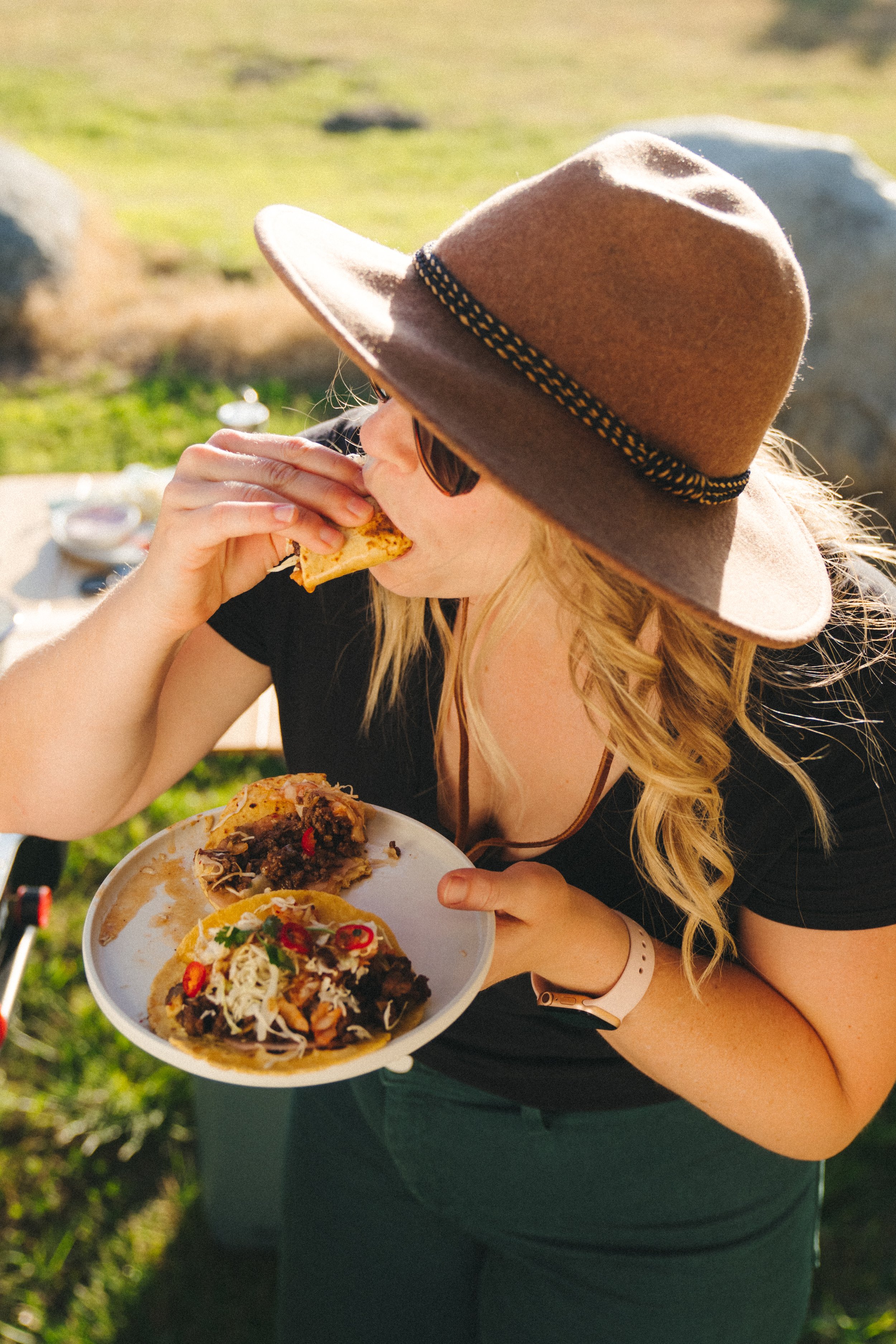CAMP RECIPE: Korean BBQ Bulgogi Tacos
Korean BBQ bulgogi tacos can be enjoyed at home or at camp!
Bulgogi, traditionally enjoyed with rice or as lettuce wraps, is to Koreans what phở is to the Vietnamese, matzo ball soup to the Jewish, the taco is to the Mexicans, and spaghetti and meatballs are to Italian-Americans. It’s the single Korean dish that has transcended far beyond its humble, and also some royal roots. Everyone has their own rendition of this sweet and savory meat dish, there’s no single “this is it” recipe. It’s even been popularized by Korean-American chef and restaurateur, Roy Choi, when he opened up the Kogi BBQ Taco truck in Los Angeles where he combined the City of Angel’s two favorite foods, Mexican and Korean, together into a taco. And now, you too can enjoy this unique blend of cultures at camp.
Ingredients for Korean BBQ bulgogi tacos
Traditionally, bulgogi is made with thinly sliced beef. To make things easier for camp, the Korean BBQ bulgogi tacos are made with ground beef.
The taco meat is seasoned with a homemade bulgogi sauce for the Korean BBQ bulgogi tacos
The marriage of Mexican tacos and Korean flavors is what make the Korean BBQ bulgogi tacos special
INGREDIENTS
Serves: 4
Prep time: 15 min
Cooking time: 20 min
Taco Meat:
1 lb ground beef
¼ an onion
2 tbsp of cooking oil, not olive oil
1 tsp salt
1 tsp pepper
Bulgogi Sauce and cabbage dressing:
8 cloves of garlic, minced
2 tbsp of ginger
2 cups of applesauce
8 tbsp soy sauce
2 tbsp sesame oil
6 tbsp rice wine vinegar
8 tbsp honey/agave/sugar
2 tbsp gochugaru chili flakes
The Rest:
2 cups of chopped cabbage
1 pack of pickled radish wrap (optional)
¼ cup cilantro
¼ of an onion, diced
½ cup of cabbage kimchi, diced
corn or flour tortillas
Can’t resist having just three Korean BBQ bulgogi tacos
DIRECTIONS
For the bulgogi sauce:
In a bowl, you’re going to make the bulgogi sauce. Put together the 8 cloves of minced garlic, 2 tbsp of ginger (if you can find the tubes of ginger paste, it makes this even easier), 2 cups of applesauce, 8 tbsp of soy sauce, 2 tbsp of sesame oil, 6 tbsp of rice wine vinegar, 8 tbsp of honey/agave or sugar, and 2 tbsp of Korean gochugaru chili flakes. Regular chili flakes are fine if the Korean ones cannot be sourced –it just doesn’t taste the same and tends to be much spicier. If using regular chili flakes, adjust the amount to 1 tsp. Mix together and taste. The sauce should be sweet first, savory second. Adjust seasoning to taste.
The addition of cabbage to the Korean BBQ bulgogi tacos ads a wonderfully fresh crunch
For the taco meat:
In a skillet, spoon in the 2 tbsp of cooking oil (anything but olive oil) and heat up the skillet on high heat until the oil starts to shimmer. Then place the 1 lb of beef into the skillet to start to break it up and start the browning process. Season the beef with 1 tsp of salt and 1 tsp of pepper. Once the meat is browned, toss in the other ½ of onion and sauté until the onions are clear and translucent.
Take a quarter of the bulgogi sauce and pour it onto the beef. Mix to incorporate the sauce into the beef. Once fully incorporated, add in another quarter of the bulgogi sauce. Saute until the sauce is thick and saucy. Save the rest of the sauce to dress the cabbage and if the taco meat needs additional seasoning.
Korean radish wraps and kimchi are key for Korean BBQ bulgogi tacos
To finish the tacos:
Lightly dress and toss the 2 cups of shredded cabbage with the bulgogi sauce. It should not be overly dressed since the taco meat will round out the sauciness of the taco.
Dice the ½ cup of cabbage kimchi, and ¼ of an onion. Set aside.
Warm up your tortillas of choice.
Time to assemble the tacos! On the tortilla, place on 1 pickled radish wrap, then the taco meat, then the diced kim chi, then the dressed cabbage, diced onion, then finally sprinkle on some cilantro. Rinse and repeat this process until all the tacos are gone.
Enjoy!
Karissa enjoying Korean BBQ bulgogi tacos













Bulgogi, traditionally enjoyed with rice or as lettuce wraps, is to Koreans what phở is to the Vietnamese, matzo ball soup to the Jewish, the taco is to the Mexicans, and spaghetti and meatballs are to Italian-Americans. It’s the single Korean dish that has transcended far beyond its humble, and also some royal roots. Everyone has their own rendition of this sweet and savory meat dish, there’s no single “this is it” recipe. It’s even been popularized by Korean-American chef and restaurateur, Roy Choi, when he opened up the Kogi BBQ Taco truck in Los Angeles where he combined the City of Angel’s two favorite foods, Mexican and Korean, together into a taco. And now, you too can enjoy this unique blend of cultures at camp.